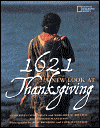|
1621: A New Look at Thanksgiving

Last updated Friday, November 4, 2005
Author: Catherine O'Neill Grace
Date of Publication:
ISBN: 0792270274
Grade Level: 5th (GLCs: Click here for grade level guidelines.)
Date(s) Used: Nov. 2005
Synopsis:
A considerable amount of information is packed into this pictorial presentation of the reenactment of the first Thanksgiving, held at Plimoth Plantation museum in October, 2000. Countering the prevailing, traditional story of the first Thanksgiving, with its black-hatted, silver-buckled Pilgrims; blanket-clad, be-feathered Indians; cranberry sauce; pumpkin pie; and turkey, this lushly illustrated photo-essay presents a more measured, balanced, and historically accurate version of the three-day harvest celebration in 1621. Five chapters give background on the Wampanoag people, colonization, Indian diplomacy, the harvest of 1621, and the evolution of the Thanksgiving story. A brief introduction and an afterword serve to set the stage and bring to a conclusion the story of incipient race relations in 17th-century Massachusetts, the impact of which is felt to the present. While debunking the Thanksgiving story as it is most frequently told, this recounting in no way detracts from the historical importance of the holiday. Pair it with Kate Waters's Tapenum's Day (Scholastic, 1996) for a penetrating alternative look at a uniquely American celebration.
| Note to readers: |
| • |
Volunteers: This book has aspects that can be dry --
it?s a challenge to discuss what is happening as you
read, and have the book come alive. As you read the
book, make sure to take the time to discuss how they
picture the scene developing, the conversations that
may have happened, what it may have looked like. You
also may want to pick and choose the chapters to read,
perhaps starting on page 18.
|
| Discussion topics for before reading: |
| • |
What do you know about the first Thanksgiving? Who
do you think was there? What did they do, and what did
they eat? Why do you think that?
|
| • |
What do you do for Thanksgiving?
|
| • |
What is your favorite part about Thanksgiving?
|
| • |
What will you give thanks for this Thanksgiving?
|
| Discussion topics for during/after reading: |
| • |
Who was at New Plymouth before the English settlers
landed there?
|
| • |
What does ?Wampanoag? mean? What do we know about
these people?
|
| • |
How did the settlers act when they landed in
America? Does this surprise you? How do you think you
would have behaved?
|
| • |
What did the settlers bring with them that was
good? What did they bring that was harmful to the
Wampanoag people?
|
| • |
What kinds of things did they find from the
Wampanogs?
|
| • |
How did these two groups interact?
|
| • |
According to this book, what really happened on the
first Thanksgiving? Who was there? How long did it
last? What did they do? Is it really all that
different from how you pictured it?
|
| • |
The book takes a definite point of view. Do you
agree with it? Do you disagree?
|
| • |
Do you think that it is important to read about
things that happened so long ago? Why or why not?
|
| • |
Discuss the evolution of Thanksgiving. What does
it mean now? Has it become a positive holiday?
|
| Craft ideas: |
| • |
Make 16-20 small cards with different aspects of
life in the early to mid 1600s, making duplicates of
each scene (so that there are 8-10 matches). Color
the other side the same colors, so that you can play
memory with the cards (switch cards with a partner so
that you don?t know what?s on the other side).
|
| • |
Make and decorate a recipe book for Thanksgiving.
|
| • |
Draw a picture of what you think you would have
looked like during this time period, and what you
would have done for fun and/or work.
|
*Note: These craft ideas are just suggestions.
You can use them, but you don't have to use them.
You can expand upon them, or add your own twist.
Remember, though, that the focus of your time should
not be on the development and execution of a craft;
the focus should be on the read-aloud and the
enjoyment of the book!
|
